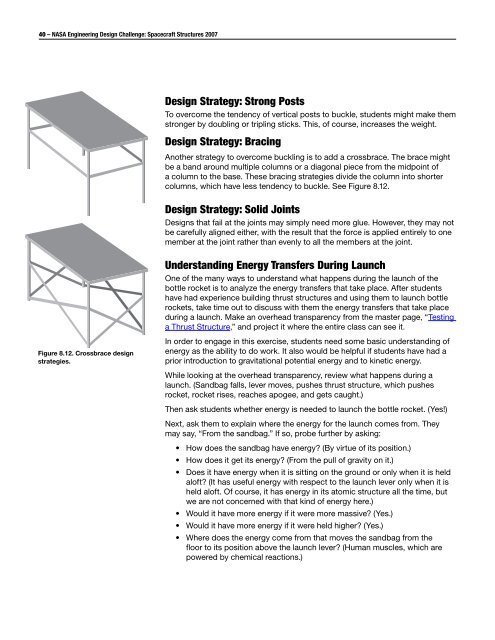Spacecraft Structures pdf - ER - NASA
Spacecraft Structures pdf - ER - NASA
Spacecraft Structures pdf - ER - NASA
- No tags were found...
You also want an ePaper? Increase the reach of your titles
YUMPU automatically turns print PDFs into web optimized ePapers that Google loves.
40 – <strong>NASA</strong> Engineering Design Challenge: <strong>Spacecraft</strong> <strong>Structures</strong> 2007Design Strategy: Strong PostsTo overcome the tendency of vertical posts to buckle, students might make themstronger by doubling or tripling sticks. This, of course, increases the weight.Design Strategy: BracingAnother strategy to overcome buckling is to add a crossbrace. The brace mightbe a band around multiple columns or a diagonal piece from the midpoint ofa column to the base. These bracing strategies divide the column into shortercolumns, which have less tendency to buckle. See Figure 8.12.Design Strategy: Solid JointsDesigns that fail at the joints may simply need more glue. However, they may notbe carefully aligned either, with the result that the force is applied entirely to onemember at the joint rather than evenly to all the members at the joint.Understanding Energy Transfers During LaunchOne of the many ways to understand what happens during the launch of thebottle rocket is to analyze the energy transfers that take place. After studentshave had experience building thrust structures and using them to launch bottlerockets, take time out to discuss with them the energy transfers that take placeduring a launch. Make an overhead transparency from the master page, “Testinga Thrust Structure,” and project it where the entire class can see it.Figure 8.12. Crossbrace designstrategies.In order to engage in this exercise, students need some basic understanding ofenergy as the ability to do work. It also would be helpful if students have had aprior introduction to gravitational potential energy and to kinetic energy.While looking at the overhead transparency, review what happens during alaunch. (Sandbag falls, lever moves, pushes thrust structure, which pushesrocket, rocket rises, reaches apogee, and gets caught.)Then ask students whether energy is needed to launch the bottle rocket. (Yes!)Next, ask them to explain where the energy for the launch comes from. Theymay say, “From the sandbag.” If so, probe further by asking:• How does the sandbag have energy? (By virtue of its position.)• How does it get its energy? (From the pull of gravity on it.)• Does it have energy when it is sitting on the ground or only when it is heldaloft? (It has useful energy with respect to the launch lever only when it isheld aloft. Of course, it has energy in its atomic structure all the time, butwe are not concerned with that kind of energy here.)• Would it have more energy if it were more massive? (Yes.)• Would it have more energy if it were held higher? (Yes.)• Where does the energy come from that moves the sandbag from thefloor to its position above the launch lever? (Human muscles, which arepowered by chemical reactions.)
















